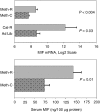Methionine-deficient diet extends mouse lifespan, slows immune and lens aging, alters glucose, T4, IGF-I and insulin levels, and increases hepatocyte MIF levels and stress resistance
- PMID: 15924568
- PMCID: PMC7159399
- DOI: 10.1111/j.1474-9726.2005.00152.x
Methionine-deficient diet extends mouse lifespan, slows immune and lens aging, alters glucose, T4, IGF-I and insulin levels, and increases hepatocyte MIF levels and stress resistance
Abstract
A diet deficient in the amino acid methionine has previously been shown to extend lifespan in several stocks of inbred rats. We report here that a methionine-deficient (Meth-R) diet also increases maximal lifespan in (BALB/cJ x C57BL/6 J)F1 mice. Compared with controls, Meth-R mice have significantly lower levels of serum IGF-I, insulin, glucose and thyroid hormone. Meth-R mice also have higher levels of liver mRNA for MIF (macrophage migration inhibition factor), known to be higher in several other mouse models of extended longevity. Meth-R mice are significantly slower to develop lens turbidity and to show age-related changes in T-cell subsets. They are also dramatically more resistant to oxidative liver cell injury induced by injection of toxic doses of acetaminophen. The spectrum of terminal illnesses in the Meth-R group is similar to that seen in control mice. Studies of the cellular and molecular biology of methionine-deprived mice may, in parallel to studies of calorie-restricted mice, provide insights into the way in which nutritional factors modulate longevity and late-life illnesses.
Figures




References
-
- Chrisp CE, Turke P, Luciano A, Swalwell S, Peterson J, Miller RA (1996) Lifespan and pathology in genetically heterogeneous (four‐way cross) mice: a new model for aging research. Vet. Pathol. 33, 735–743. - PubMed
-
- James SJ, Melnyk S, Pogribna M, Pogribny IP, Caudill MA (2002) Elevation in S‐adenosylhomocysteine and DNA hypomethylation: potential epigenetic mechanism for homocysteine‐related pathology. J. Nutrition 132, 2361S–2366S. - PubMed
-
- Masoro EJ, McCarter RJ, Katz MS, McMahan CA (1992) Dietary restriction alters characteristics of glucose fuel use. J. Gerontol. 47, B202–B208. - PubMed
-
- Miller RA (1995) Immune system In Handbook of Physiology. Section 11: Physiology of Aging (Masoro E, ed.). New York: Oxford University Press, pp. 555–590.
-
- Miller RA (1997) Age‐related changes in T cell surface markers: a longitudinal analysis in genetically heterogeneous mice. Mech. Ageing Dev. 96, 181–196. - PubMed
Publication types
MeSH terms
Substances
Grants and funding
LinkOut - more resources
Full Text Sources
Other Literature Sources
Miscellaneous

